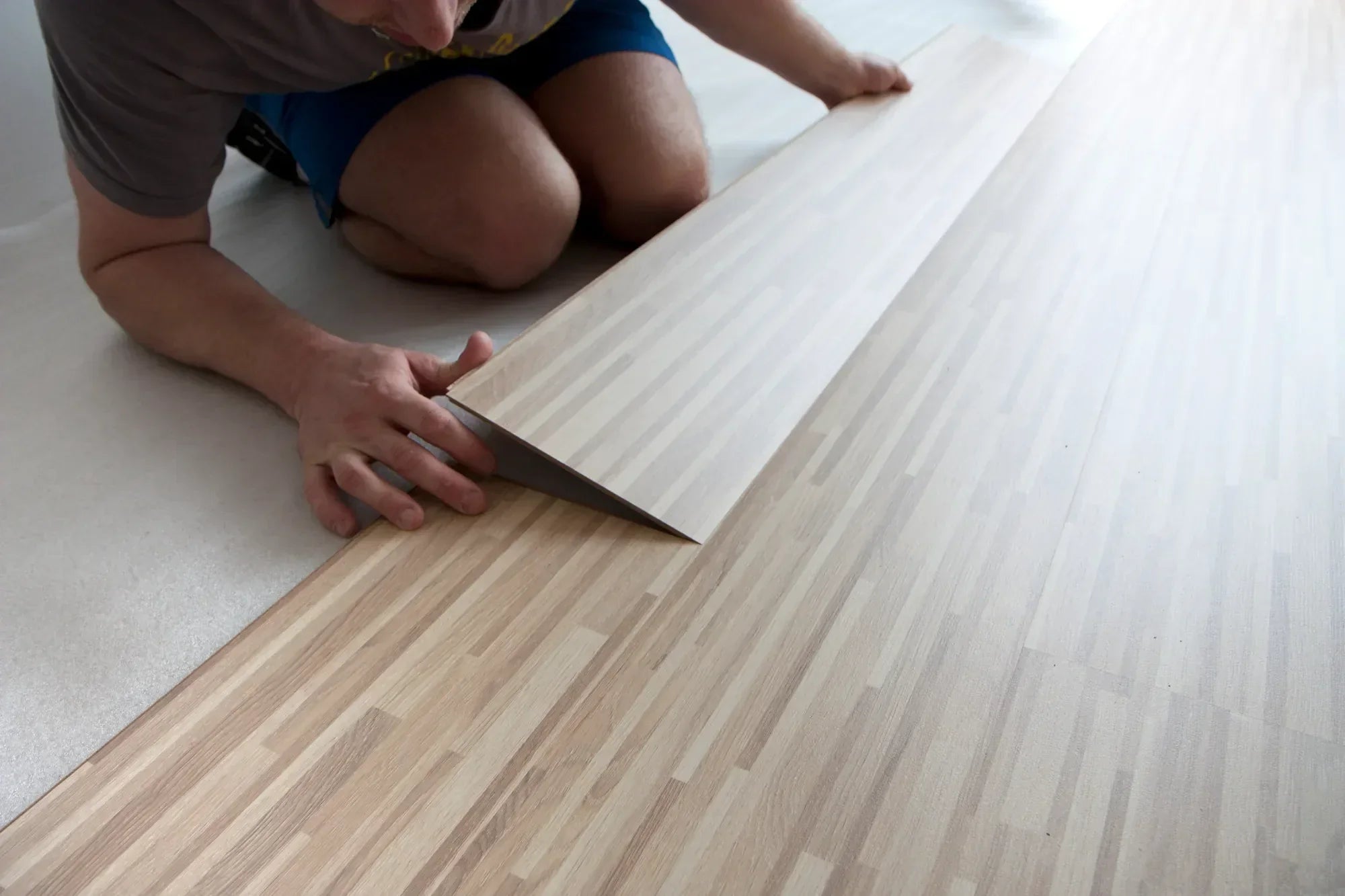Discovering that your floating laminate flooring is warping can turn your daily life into a real headache. This phenomenon, unfortunately common in Quebec homes, manifests itself as planks that lift, create bumps, or form visible ripples. Contrary to popular belief, a floating laminate floor that is warping does not necessarily mean that your flooring is defective.
Warping is usually the result of environmental factors or installation errors that you can correct. Excessive humidity, temperature fluctuations typical of the Quebec climate, or insufficient expansion space are the main causes. Fortunately, solutions exist for every situation.
In this guide, we will explore the specific causes of warping, effective diagnostic methods, and most importantly, practical solutions for restoring a perfectly flat floor.
Summary
- Why is your floor warping?
- Identify the signs of warping
- Solutions to repair your floor
- When to consult a professional
- Steps to Prevent Future Warping
- Conclusion
- FAQ
Why is your floor warping?
Understanding the causes of warping will allow you to choose the appropriate solution and prevent the problem from recurring.
Humidity: the main enemy
Humidity is the number one cause of warping. Laminate is made of compressed wood fibers covered with a decorative layer. This composition makes it particularly sensitive to changes in ambient humidity.
When humidity exceeds 60%, the fibers absorb this moisture and swell. This expansion causes the slats to lift, as they have nowhere to expand. The problem resolves during the Quebec winter, when heating dries out the indoor air.
Sources of excessive moisture include high ambient humidity, water infiltration, plumbing problems, poor bathroom ventilation, or rising damp from the basement. You must identify and eliminate these sources before any repairs.
Insufficient expansion spaces

The second major cause is improper installation. Your floating laminate floor requires an expansion gap of at least 8 to 10 millimeters around the entire perimeter. This gap allows the floor to expand naturally.
Without this vital space, your floor will bump against the walls as it expands. This pressure results in the planks lifting in the center of the room. This problem frequently occurs during installations carried out by DIYers who neglect this crucial step.
Subfloor defects
An improperly prepared subfloor can cause problems even with quality laminate. Unevenness, bumps, or dips larger than 3 millimeters create mechanical stress on your planks.
Moisture from the subfloor poses a particular challenge in basements. Without an adequate vapor barrier, moisture rises and directly affects your floor.
Identify the signs of warping
Recognizing the early signs allows you to intervene before the problem gets worse.
Visual and tactile signs
Warping manifests itself as visible deformations. Your boards have localized bumps, ripples, or lifts. These deformations become particularly visible when natural light hits the surface.
When you walk on the affected areas, you may feel a "trampoline" effect under your feet. Your floor may also make creaking or squeaking noises as you walk.
Diagnostic tools
Take a two-meter straight edge and place it on the surface to highlight the deformations. Observe the gaps between the ruler and the floor: these will give you a clear idea of the extent of the problem. Then use a spirit level to check the extent of these deformations.
| Type of deformation | Amplitude | Recommended action |
|---|---|---|
| Light ripple | 1-3 mm | Humidity control |
| Moderate uprising | 3-6 mm | Adjusting the dilation |
| Significant warping | 6+ mm | Replacing the blades |
Solutions to repair your floor
Humidity control
If excessive humidity is causing the problem, reduce the humidity level to between 30% and 50%. Use a dehumidifier in problem areas, especially basements.
Maintain this humidity level for several weeks. This approach will allow the laminate to return to its original dimensions. In some cases, this intervention will be enough to resolve the warping.
Correction of expansion spaces
When a lack of space causes warping, you need to create or enlarge these spaces. This requires removing baseboards and precisely cutting the flooring around the perimeter.
Use an oscillating saw to cut the laminate without damaging the walls. Maintain a uniform gap of 8 to 10 millimeters around the entire perimeter.
Replacing damaged blades
In cases where warping has caused irreversible damage, partial replacement becomes necessary. Use identical blades, ideally from the same production batch.
When to consult a professional
Some situations require the intervention of a qualified expert to effectively resolve the problem.
Complex problems

Extensive problems over large areas usually indicate structural causes that go beyond simple repair. Professionals have advanced diagnostic tools such as professional hygrometers.
At Emard Couvre-Planchers, our experts quickly diagnose the causes of warping. Our experience allows us to offer long-lasting, guaranteed repairs.
Long-term savings
Hiring a professional represents a larger initial investment, but often results in long-term savings. A poorly executed repair can make the problem worse.
Steps to Prevent Future Warping
1. Environmental control
Maintain a stable environment by monitoring humidity levels with a hygrometer. Act quickly if there are significant fluctuations. Maintain relative humidity between 30% and 50%. Health Canada recommends these levels to preserve your flooring.
Install adequate ventilation, especially in humid rooms. Make sure fans (such as those in the bathroom or kitchen) are running properly when showering or cooking.
2. Regular maintenance
Visually inspect your floor monthly, especially at the change of seasons. Clean with products specifically designed for laminate flooring. To discover other flooring options, check out our vinyl flooring trends .
3. Professional installation
The quality of the initial installation determines the durability of your floor. Professional installation ensures proper expansion spaces and adaptation to the specific characteristics of your environment.
Conclusion
A warping laminate floor isn't inevitable. With a clear understanding of the causes and the application of appropriate solutions, you can effectively resolve this problem.
Excessive moisture, installation defects, and subfloor problems are the main causes. The key to success lies in an accurate diagnosis followed by appropriate intervention.
Whether you choose to carry out the repairs yourself or call in professionals, the important thing is to act quickly. Prevention, through environmental monitoring and regular maintenance, remains your best ally.
Is your floating laminate floor warping and you'd like professional expertise? Contact our team at Emard Couvre-Planchers for an accurate diagnosis and lasting solutions.
FAQ
Why won't my warped laminate flooring return to normal after checking the humidity?
If your warped laminate flooring doesn't return to its original shape despite proper moisture control, the core fibers have suffered permanent damage. When exposed to moisture for a long time, the fibers lose their ability to return to their original dimensions. You'll then need to replace the affected planks.
How long does it take for laminate flooring to stabilize after repair?
Stabilization typically takes between 2 and 4 weeks, depending on the extent of the initial problem. During this time, maintain a stable humidity level between 30% and 50%. Avoid significant fluctuations that could compromise stabilization.
Can you install a floating laminate floor in a basement?
Installation in a Quebec basement is possible, but requires special precautions. A quality vapor barrier, strict humidity control, and adequate ventilation are essential. Choose a laminate designed for humid environments.
Do seasonal variations affect laminate flooring?
Yes, significant seasonal variations can affect your flooring. In winter, heating dries the air and can cause contraction. In summer, higher humidity can cause expansion. A well-regulated air conditioning system helps minimize these effects.



